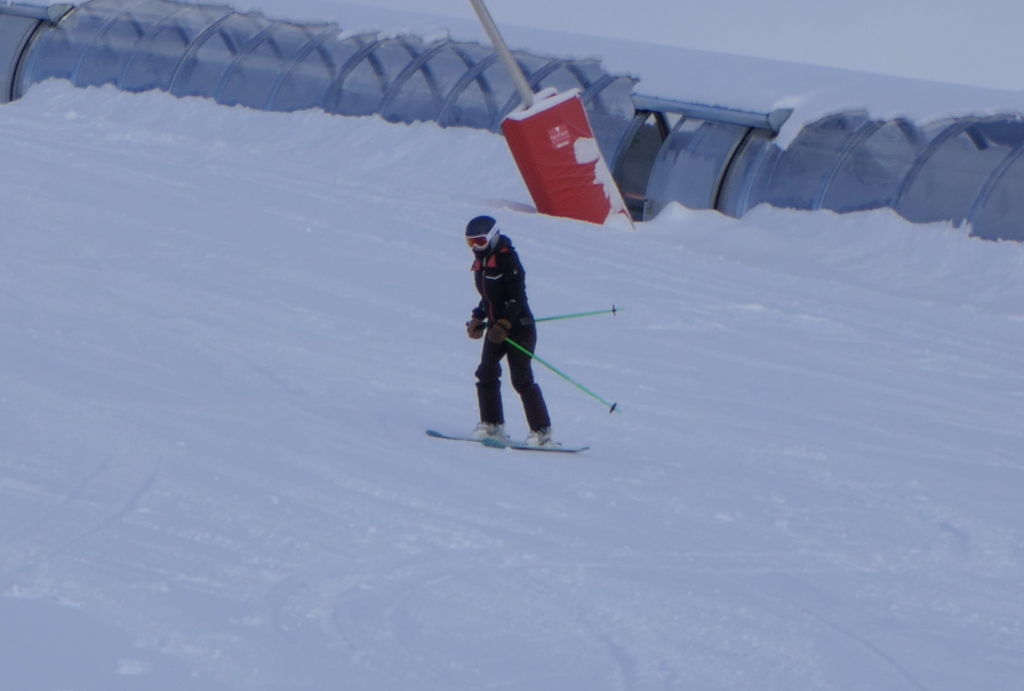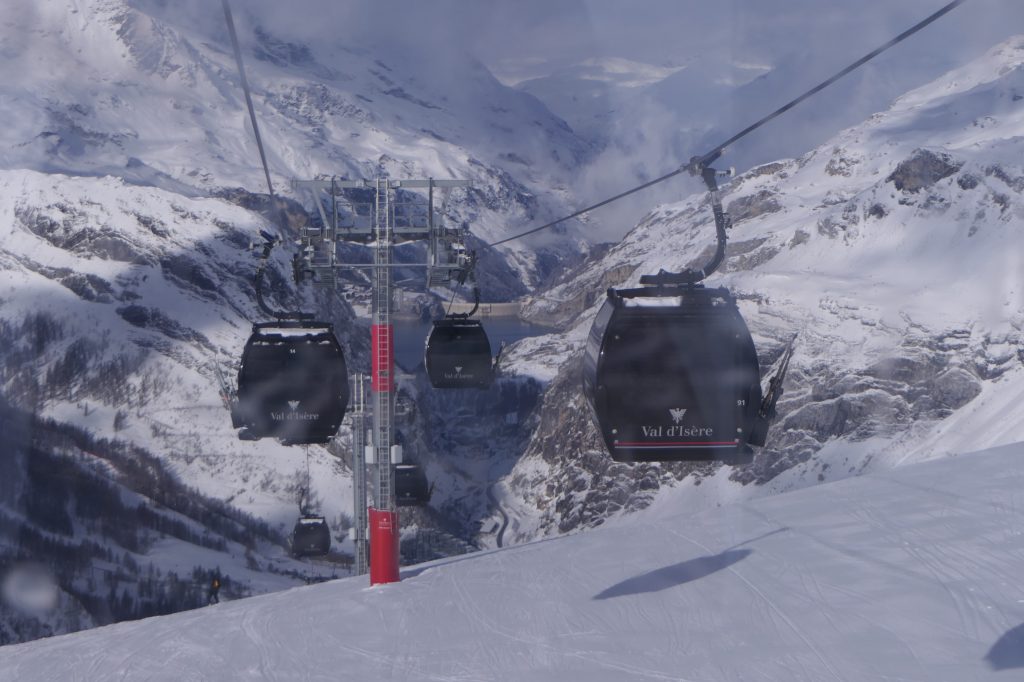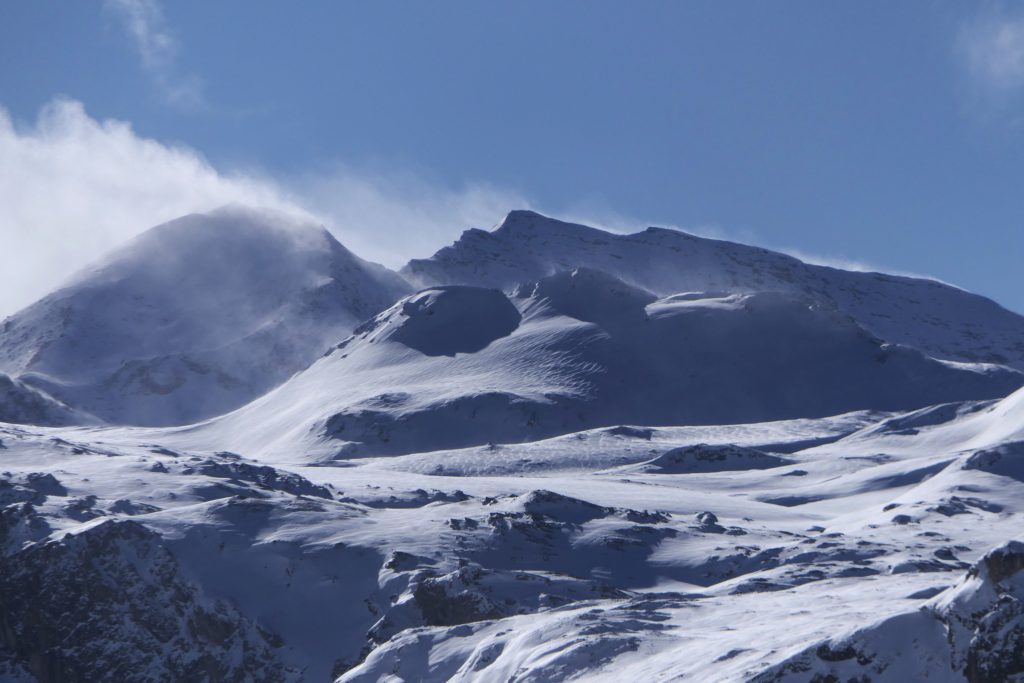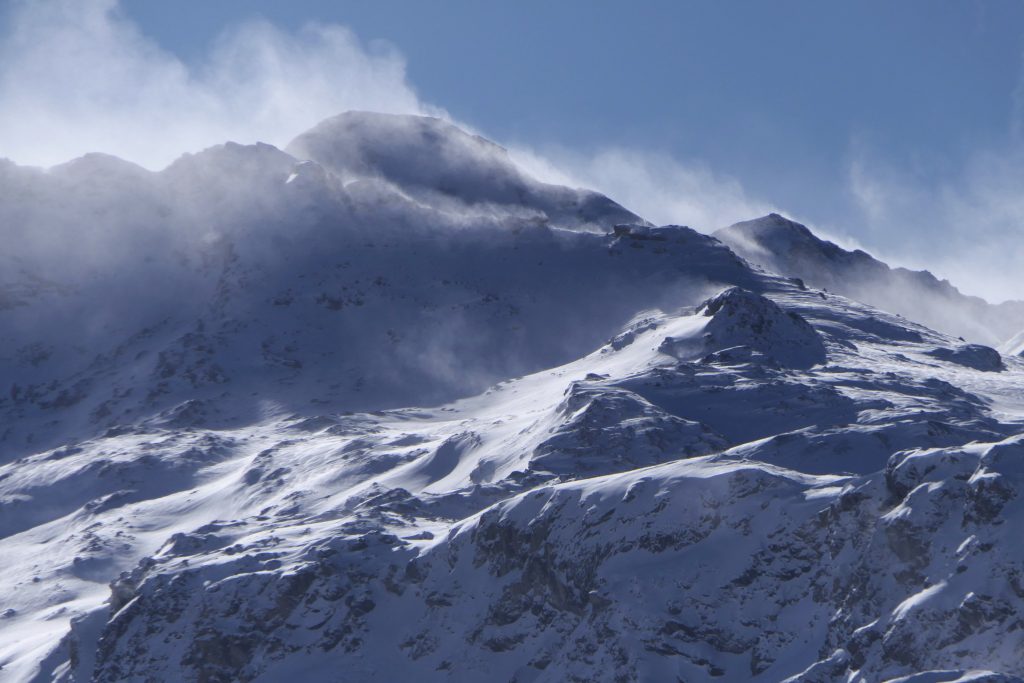- Skating/Adductors
- Basic Dynamics (skis parallel)
- Sideslipping (Joystick control)
- Pivot
- Combining pivot and dynamics
- Advanced Dynamics
- Mountain photos today…
Prior to working on Danae’s skiing we filmed a short section to record how she is using body rotation to make a turn – even ending the turns with the shoulders facing uphill (photo). This is an emotion driven action to force the skis to turn which makes skiing “precarious” and hard work. We then started work on changing things at a fundamental level. Fortunately Danae is a skater – which is ideal.

Clear use of dynamics with a definite skating action – once Danae gets used to doing this on those steeper slopes the dynamics will become more visible and effective. Stick to the skating action – it is providing natural “angulation” and automatically prevents rotation – giving a solid platform and security.
Skating/Adductors
Skiing is just disguised skating. The main difference is the skis are wide and have two edges. When diverging the skis outwards at the tips into a skating stance the skis want to flatten on the snow and the stiff shaft of the ski boots will pull the knees outward. The adductor muscles need to be engaged to hold the skis on their inside edges. This is a pattern of muscle use – the adductors of both legs contracting – that should be maintained when skiing parallel. This is partly dependent on the skier’s morphology. If the femurs are naturally directed inwards less adductor use might be appropriate but if slightly bow legged there may be a need to consciously work the adductors.
Only when snowplough braking should the adductors be released to widen the spreading of the tails of the skis from the hip joints.

The other difference between skis and skates: – it’s just that skis bend and scribe arcs on the ground and are generally used on slopes not flat lakes. Skating actions are fundamental for a skier’s development because they involve independent leg action where only one leg at a time is really used. Although skiers can stand on two feet the body is oriented specifically on one hip joint at a time (when turning) and has to function as if standing on one leg. Skating exercises such as skating step turns are helpful in developing basic skills. Skating turns use diverging skis (opposite from snowplough) and incremental stepping of the centre of mass inward toward the turn centre. This is ideally the first sort of turning that any complete beginner should experience – on flat terrain.
Basic Dynamics (skis parallel)
- Skis must be travelling forward – like a bicycle
- This is mainly about using the outside leg (start of new turn) to push the centre of mass into the centre of the new turn – for the whole duration of the turn
- There is no “balance” when skiing – dynamics is the physics of disequilibrium
- You are looking for stability from organised accelerations (ski technology!)
- Notice in the photos below the outside leg is essentially straight in a skating action (flexion for absorption and other purposes is primarily at the hip joint)
- The centre of mass goes down toward the snow – and to complete the turn it comes back up – like a motorbike in a turn
- There is no “Centrifugal Force” acting on the skier – only a deflection inward away from a straight line. This deflection is used to lift the skier up at the end of the turn – which involves “finishing” the turn – I.E. turning almost back up the hill.
- Remain square to the skis (follow the skis around the turn with your body) until you are really comfortable with movement of the centre of mass and clearly aware of moving it.
Model photos showing unambiguous dynamics…



Sideslipping (Joystick control)
The main practical purpose of sideslipping is to get down the mountain without picking up speed. Many learners are deprived of this skill because it is generally undervalued and has become even more neglected due to the complete domination of carving skis. Wider skis are easier for sideslipping in a greater range of conditions. Parabolic skis have some trouble gripping on ice during a sideslip, but modern “double rocker” off-piste skis give a smooth and grippy sideslip in just about every condition, including ice. I currently highly recommend the K2 Kung Fujas as a great all mountain ski. (…old tech now!)
The skis are kept on edge by the lateral stiffness of the ski boot shafts. Skis over 100mm wide underfoot begin to create problems on hard snow due to the extra leverage from the edge through the shaft of the boot. Those skis can be very unpleasant on-piste and it’s one limit of how an “all round” ski can be defined. Anything wider than 100mm is not “all round”. In ski teaching the sideslip serves specifically for developing fall-line skiing. Fall-line skiing is where the skier’s body travels directly downhill and not across the hill. This would apply to bumps, steep off-piste such as couloirs and deep powder snow. Slalom is not “fall-line” skiing. The skier should be able to sideslip on either ski or both at the same time. It’s normal to start off with both skis on the snow, skis parallel and with the majority of weight on the lower ski just to get a feel for it. The stance is normally quite narrow to prevent the uphill ski from catching the lower edge. Most beginners have trouble keeping the skis close together.
It should be noticed that only the uphill edges of the skis are in contact with the snow so the downhill edges are in the air. If the fronts of the skis are pushed downhill (Joystick Control – moving the Centre of Mass forward) then there will be no resistance from the downhill edges and so the skier goes into a forward diagonal sideslip. Likewise if the tails are pushed downwards during the sideslip then it turns into a backwards diagonal sideslip. Being able to alternate between straight down the fall-line and the two diagonals is a precursor to the skill necessary for pivoting in the fall-line. Both legs need to squeeze the adductor muscles together – holding the upper legs close together. Pulling both legs together keeps a narrow stance and when the skier practices sideslipping on one leg it ensures the that the geometry of the edge angles to the slope are optimum for pivoting.
Pivot
After learning skating turns on the flat this is the way beginners should learn to turn for dealing with gradients. They should be assisted if required – by holding a ski pole at the side of the instructor and being physically led through all the moves – just like someone being led in a dance. Eventually the skill is assimilated due to the body being fed the correct feeling repeatedly. Some athletic beginners can cope with this manoeuvre on their own.
The reason for this pivot is to develop fall-line skiing skills. It’s a “braking” form of turn which gives great control over speed – because of the skis only being used on uphill edges. The other important element of this pivot is that both feet are kept downhill of the skier (vertically below the skier) which is not only a fun and playful way to ski but is critical for safety on dangerous steeps such as in couloirs. Most people are totally brainwashed in the skiing world into believing that a ski only turns because of its inside edge with its sidecut. Well it does, but not all of the time. The ski can also turn while on its outside edge during the first half of a turn. If someone has already worked on a forward diagonal sideslip then they already partly know the mechanism for this.
The skier has to stand on the uphill ski only, lifting the lower ski off the snow. The foot should feel pressure on its outside edge but the adductor muscles of this leg should be pulling in the downhill direction. The ski will remain on its outside edge (due to the lateral support of the ski boot shaft preventing the ski from flattening). The downhill pole should be planted for support and so when the lower ski is lifted the body weight should be partially transferred to the pole. This requires the skier to face downhill and tilt forwards from the hips (angulation). Place the centre of mass downhill as much as possible with the use of support from the ski poles. Try to keep the ski on its uphill edge while the centre of mass moves downhill of it. The use of the pole here is to support and guide the centre of mass – which then pulls the ski tip downhill along with it. (In dynamics skiing with forward motion of the ski the pole is not required because the support for the centre of mass comes from the lifting up power of the ski itself. This is why pole planting is only associated with pivoting and not with dynamic skiing – where only a pole touch at most is required when entering a turn)
The adductor muscles of the outside leg continue to be engaged to allow the centre of mass to pull the front of the ski downwards in a sideslip into a turn. This trains the correct muscular coordination – pulling inwards towards the turn centre with the adductor muscles.
To check that the adductor muscles are being used the “Pole Stopper” exercise is useful. For this exercise I place a ski pole between the tips of the two skis. The skier lifts a ski a few inches off the snow and then pulls the tip against the pole. If the adductor muscles are being used then as the tip is blocked the tail should swing inwards at the back. If the tail swings outwards then the it’s the muscles on the outside of the leg (abductors) being used to push and twist rather than the adductors (inside of the leg) being used to pull or tension the leg.
When the pivot starts the skier (centre of mass) has to move downhill slightly from the ski but not too much because the ski must remain on the uphill edge for as long as possible. Moving the body too much downhill would change the ski edges far too quickly – for this effect the ski must be allowed to sideslip right from the beginning. The ski will change edges when it is in the fall-line, onto the new “inside” uphill edges for the last part of the turn. All the time – from start to end of the turn the skier needs to pull inwards and tension the adductors.
Completing the turn correctly requires the skier to avoid body rotation and to have the body in an anticipated and angulated stance, ready for another pole plant at the start of the next turn.
Combining pivot and dynamics
The basic “pivot” initialises a turn from the uphill ski – uphill (outside) edge. In dynamic skiing (with skis running forward) the same edge provides a platform for pushing off early to start the next turn. The ski will start the turn with a slight pivot action naturally and the engaged uphill edge will guarantee there is no slipping outwards of the ski during the “push” – assuring a clear directing of the centre of mass into the new turn. This flexed “uphill” leg permits a strong push which has to be executed consciously and deliberately.
Advanced Dynamics
Creating “angulation” (resembles dropping one cheek of your bottom onto a chair). This gives the appearance of “facing downhill” in shorter turns. It’s a movement made by letting go – a relaxation at the hip joint (outside leg) and a falling into the turn particularly in the second half of the turn.
The turn initiation is with the skier facing downhill – thrusting the body downhill while the skis travel across the hill.

Mountain photos today…




